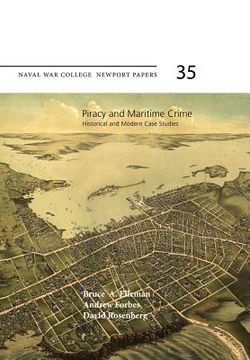Piracy and Maritime Crime: Historical and Modern Case Studies: Naval War College Newport Papers 35 (en Inglés)
Reseña del libro "Piracy and Maritime Crime: Historical and Modern Case Studies: Naval War College Newport Papers 35 (en Inglés)"
Piracy is a basic and fundamental concern for all navies. From almost the beginning of state-sponsored navies, piracy suppression has been one of their major responsibilities-when Julius Caesar was captured by pirates in 76 BCE, the first thing he did after paying the pirates' ransom and being released was to fit "out a squadron of ships to take his revenge." Despite piracy's importance and the continued frequency of piratical attacks, however, relatively few scholarly works have been written analyzing cases of modern piracy and piracy suppression in terms of varying strategic, policy, and operational decisions. This edited collection of case studies attempts to fill this gap. There have been a number of important historical studies that have dealt with the subjects of piracy and piracy suppression. Books written from the point of view of those wishing to end piracy have tended to focus on legal issues, including the rights of victims, the procedures and decisions of Admiralty courts in punishing pirates, and the capture of piracy ships as prizes. Others have looked at the existence of piracy in terms of one particular place or time period, with the Barbary Coast and the Caribbean Sea claiming disproportionate shares of attention. At the turn of the eighteenth century, the Royal Navy was primarily responsible for using force to suppress piracy. British privateers continued to roam the seas, preying on Spanish gold. However, several changes in British maritime legal practice made a renewed fight against piracy possible. On 13 October 1696, Sir Charles Hedges, judge of the High Court, revised Admiralty law so that pirates could be punished anywhere: "Now piracy is only a sea term for robbery, piracy being a robbery committed within the jurisdiction of the Admiralty. If any man be assaulted within that jurisdiction, and his ship or goods violently taken away without legal authority, this is robbery and piracy." Antipiracy reforms were not enacted rapidly, but by the 1720s the Royal Navy had made it easier for its officers to prosecute pirates anywhere in the world. During this period, Newport, R.I. (pictured on the front cover), was used by Thomas Tew to trade in pirate cargo, with one cargo alone valued at 100,000. The Royal Navy attacked pirates in the Caribbean, along the coast of North America, and as far away as the Indian Ocean.With the creation of new bases, such as at Antigua in the West Indies, the Royal Navy gradually extended its range as far as the northwest Pacific and Australia: "Naval stations and cruising areas gradually covered the shipping zones of the world and made possible the Pax Britannica." For many people, it appeared that piracy had been destroyed for good. Even fairly recent books focusing on the nineteenth century have included chapters entitled "An End to Piracy." However, piracy never entirely disappeared during the twentieth century, and during the last quarter of that century events turned out far differently than even the most pessimistic observer could have predicted. This monograph is intended as a contribution to both scholarship and professional naval thinking; it is an academic and comparative examination of twelve selected case studies from maritime history used to illuminate a range of concepts and uses of piracy suppression. The twelve case studies provide the basis for the conclusions, an approach that provides a more thorough understanding of the uses and limitations of naval antipiracy operations in the context of new maritime technologies and within a wider range of modern national policy goals than might otherwise be achievable. Above all, this collection provides a sound basis for comparative analysis of varying historical experiences that can stimulate new and original thinking about a basic but often overlooked naval duty.

